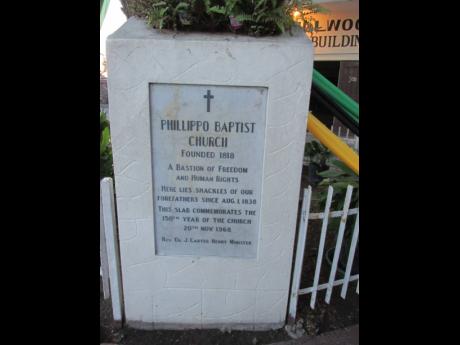Churches and missionaries under attack
IN THE years leading up to the Sam Sharpe Rebellion of 1831 and right after, pro-slavery conformists, including members of the Anglican Church, and anti-slavery agitators, including Christian missionaries, clashed all over Jamaica, with the former group invariably being the aggressors. The efforts of the abolitionist missionaries were a major threat to their livelihood and survival. Slavery in the British West Indies was big business.
Without the free labour of the enslaved, plantations were not economically viable, and so the planters turned upon the missionaries with vengeance and vitriols. Legal actions, physical attacks, destruction of properties and exile were some of the ways in which pro-slavery people and organisations persecuted anti-slavery agitators and campaigners, more so missionaries. Fourteen Baptist churches and six Methodist chapels were burnt or extensively destroyed. At one point it was the Colonial Church Union (CCU) that led the charge with much vigour and invective.
The CCU was established in the rectory of the St Ann Parish Church by the rector himself, Reverend George Bridges, on January 26, 1832, exactly one month after the trash house was lit on Kensington Estate in St James. He was a pro-slavery racist who published anti-African and anti-missionary letters regularly in the Jamaica Courant newspaper. His fiery sermons would inspire some members of his flock to intimidate people who did not support slavery. The Methodists were the ones who were in his line of fire more than any other.
And it was not just a metaphorical line of fire. Missionaries’ homes were actually shot up while they lay in bed at night. Many fled western Jamaica for Kingston, lest they be assassinated. Much physical violence was brought upon them. It was so bad that the Methodists had to write the Missionary Committee in London about the brutish treatment that was meted out to them. They gave the examples of how the chapel in Port Antonio, Portland was closed by magistrates under the pretence of preserving it from demolition, and how missionaries, Peter Duncan and John Barry were prevented from leaving the island before they paid their debts.
They also cited the brutal physical attacks on Reverend Henry Bleby and his wife in Falmouth, Trelawny; the arrest, conviction and imprisonment of a Mr Greenwood on the grounds that he was not licensed to preach; the closure of the Baptist and Methodist chapels in Montego Bay; the arrests and imprisonment of Baptist missionaries, Abbott and Nichols, and Methodist Missionary Murray for preaching; how Missionary Wilcox had to preach secretly in St Dorothy; and the cases of missionaries Whitehouse and Wood, who had been arrested on their way to Kingston from St Ann.
In the case of Wood, Lloyd A. Cooke writes in his book, The Story of Jamaican Missions, “Suffice it to say that he had a most harrowing day, being verbally attacked in the court by some of the leading men of the militia and magistrates of the parish who were members of the Colonial Union. Much vile accusations, cursing and threats were directed his way”.
In order to legitimise their attacks, the CCU passed a resolution to remove all missionaries from Jamaica. This prompted a proclamation from the King of England, to be circulated by Governor Lord Mulgrave to the parish custodes for publication. The king proclaimed his religious tolerance and that the missionaries were free to preach in Jamaica. He also condemned the rampant violence on the island.
However, Cooke writes, “The king’s proclamation was not headed. The governor’s circular was everywhere discounted and torn down from places where it was posted. The magistrates continued to act as they had done before. Thus, the governor took his firm stand at Brown’s Town in St Ann, publicly cashiering (firing) some militia officers. Only after this did the [Colonial Church] Union begin to lose power and favour”.
Governor Mulgrave was firm and swift in response to what he heard about the CCU. There were more dismissals and resignations. On January 9, 1833 he cancelled the commissions of two officers of the St John’s Troops who had signed the declaration of the CCU, whose members were so upset with the new governor that they burned his effigy in the streets of St Ann’s Bay.
That was perhaps their last incendiary action.
Cooke writes, “Before its spectacular and public slaying, however, this beast (the CCU) had managed to terrorise the island for 18 months. It organised branches in most parts of the island, except in Kingston, where its attempt to organise were staunched by the people, especially the coloured”.
And 17 months after the CCU was established, the The Emancipation Act was passed. Reports by the missionaries were instrumental in the passage of the said act.

